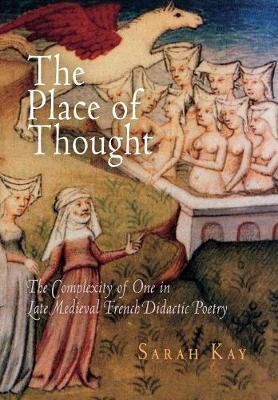The Middle Ages
2 total works
From Jean de Meun in the late thirteenth century to Christine de Pizan in the early fifteenth, medieval French poets often aimed to impart theological, philosophical, or moral ideas. To unify their thought, and to make its outline visible to readers, the poets created vivid images of place, such as gardens, paths, idyllic landscapes, cities, trees, and fountains. For Sarah Kay, these spatial images are a prop of "monologism," helping to communicate (or impose) unity of meaning and interpretation by summoning readers to occupy the same "place" in their thinking as the authors. Because of this monologism, Kay contends, didactic poetry has been ill served by a critical tradition that favors difference, plurality, and dialogism. In The Place of Thought, she seeks radically to reassess this literature and reappraise the pleasure to be derived from reading it.
Kay argues that one meaning is not inherently simpler or less interesting than many meanings. Using specific works as examples, she demonstrates that this "one-ness" of thought in French didactic poems can be an excitingly complex and challenging notion, and that it strains the images in which it is placed to the point where they become difficult to visualize. Herein lies the poems' simultaneous intellectual and aesthetic appeal. Focusing on the Roman de la Rose by Jean de Meun, the Breviari d'amor by Matfre Ermengaud, the Ovide moralisé, Pèlerinage de vie humaine by Guillaume de Deguileville's, Le Jugement dou roy de Navarre by Guillaume de Machaut, Le Joli buisson de Jonece by Jean Froissart, and Le Livre du Chemin de long estude by Christine de Pizan, Kay traces the works' backgrounds in scholastic thinking, illuminating them when appropriate with modern reflections on the same ideas.
The love songs of Occitan troubadours inspired a rich body of courtly lyric by poets working in neighboring languages. For Sarah Kay, these poets were nightingales, composing verse that is recognizable yet original. But troubadour poetry also circulated across Europe in a form that is less well known but was more transformative. Writers outside Occitania quoted troubadour songs word for word in their original language, then commented upon these excerpts as linguistic or poetic examples, as guides to conduct, and even as sources of theological insight. If troubadours and their poetic imitators were nightingales, these quotation artists were parrots, and their practices of excerption and repetition brought about changes in poetic subjectivity that would deeply affect the European canon.
The first sustained study of the medieval tradition of troubadour quotation, Parrots and Nightingales examines texts produced along the arc of the northern Mediterranean-from Catalonia through southern France to northern Italy-through the thirteenth century and the first half of the fourteenth. Featuring extensive appendices of over a thousand troubadour passages that have been quoted or anthologized, Parrots and Nightingales traces how quotations influenced the works of grammarians, short story writers, biographers, encyclopedists, and not least, other poets including Dante and Petrarch. Kay explores the instability and fluidity of medieval textuality, revealing how the art of quotation affected the transmission of knowledge and transformed perceptions of desire from the "courtly love" of the Middle Ages to the more learned formulations that emerged in the Renaissance. Parrots and Nightingales deftly restores the medieval tradition of lyric quotation to visibility, persuasively arguing for its originality and influence as a literary strategy.

